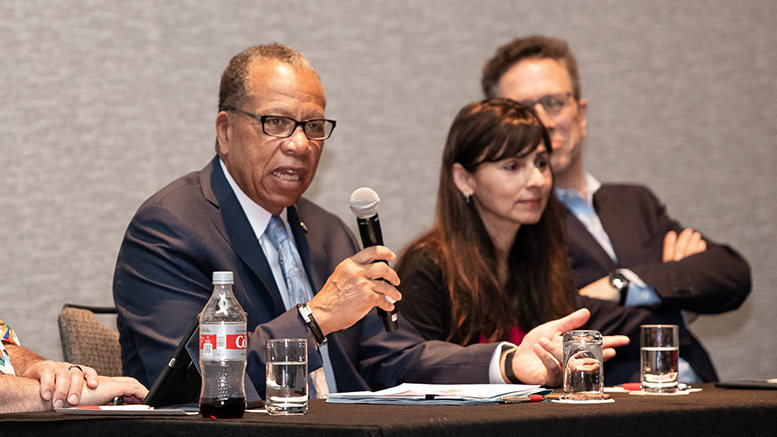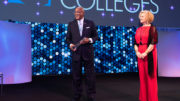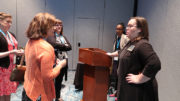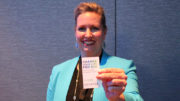ORLANDO, Fla. — The idea of creating guided pathways is pretty well accepted by community colleges, but the implementation piece is challenging.
“This is complex institution-wide work,” said Kay McClenney, a senior advisor to American Association of Community Colleges (AACC) President Walter Bumphus. She moderated a panel discussion on guided pathways on Monday during the AACC annual convention.
Eighty percent of this work involves a cultural shift, added Davis Jenkins, senior research associate at the Community College Research Center. Students need to have a full program plan spelling out what courses to take, how much it will cost and how long it will take to complete, Jenkins said.
“We have to stop thinking about the idea that students are lacking in skills and knowledge when what they lack is confidence as learners,” Jenkins said. Developing confidence comes from having a well-taught course that focuses on active learning where students are taught to think.
Momentum points
At Bakersfield College in California, one of the colleges in the first cohort of the AACC Pathways Project, President Sonya Christian found it was important “to hone in on momentum points.”
One of those points is when a student completes 15 credits, Christian said. “That sets you on a winning trajectory to complete a degree or certificate,” she said.
Bakersfield restructured the role of counselors to have them focus on getting to that momentum point and to reach out to high schools to stress the importance of completing 15 credits and sharing data on why that is so critical.
Moving from course success to completing momentum points had a huge impact, especially on the most vulnerable students, including minorities and rural poor. Among African-Americans, those who completed a college-level English course the first year increased from 14 percent to 24 percent the following year and to 34 percent a year later, Christian said.
At the beginning of the pathways work, Christian said she didn’t understand the importance of program mapping. “The mapping exercise if fundamental,” she said, but the maps have to be transparent and visible to students, and career and technical education courses need to be included in the course-sequencing maps for majors.
Structural transformation
To implement a pathways model, colleges need different types of leadership at all stages, said Rob Johnstone, founder and president of the National Center for Inquiry and Improvement. They also need to rethink how a campus is structured, so it’s better equipped to carry out problem solving and design.
Developing a pathways structure is unique at every college, Johnstone said. College leaders have to put together functional work groups, identify the problems they are trying to solve, and decide how to operationalize this work. This requires large-scale institutional change.
According to Johnstone, when the pathways concept first caught on, there was too much talk about course mapping and not enough about how pathways promote equity.
“What good are maps or meta majors if students don’t have a plan to get through college?” he said. “We have to fundamentally change the student experience at scale. It is that focus, along with social justice and equity, that has to drive this work.”
Transforming the culture
At Cuyahoga Community College (Tri-C), President Alex Johnson looked to transform the culture of the institution to promote student success in a more comprehensive way.
At the time, the college had to respond to outside forces, including concerns in the community about the skills gap and a new state funding formula based on performance, graduation rates and courses completions, said Johnson, chair-elect of the AACC board of directors.
Instead of having 140 programs, Tri-C now has 10 pathways. The college also implemented intentional and mandatory experiences for students, such as a success course and individualized attention, and adopted mapping software to help students develop an academic plan with counselors.
As a result of transforming the organization, the graduation rate went up 500 percent, Johnson said, and the number of workforce credentials went from 1,000 to 16,000.
But, Johnson said, “if you don’t have faculty involved in all these endeavors you can forget about being successful.”
Johnson added that the college culture has to embody a sense of engagement.
“The president needs to do that before considering pathways,” he said. “The narrative has to change from focusing on numbers to a focus on outcomes.”





